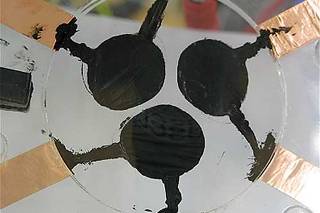Jun 17 2015
A team of scientists at the University of Bristol have designed an artificial skin that can be transformed at the flick of a switch, mimicking the camouflage properties of squids.
Inspired by biological chromatophores, the scientists from the Department of Engineering Mathematics at the University of Bristol developed a smart material system that creates designs which transform and morph over time, mimicking biological patterns. The study has been published in the Journal of the Royal Society Interface. It elucidates the mathematical modelling, design, simulation and analysis of a complex and dynamic biomimetic pattern generation system.
 Three prototype artificial cephalopod chromatophores shown in unactuated states. The chromatophores are made from dielectric elastomer using tape coated with black carbon grease electrodes. Image Credit: University of Bristol
Three prototype artificial cephalopod chromatophores shown in unactuated states. The chromatophores are made from dielectric elastomer using tape coated with black carbon grease electrodes. Image Credit: University of Bristol
The scientists showed that the artificial skin can successfully copy the action of biological chromatophores. They used thin sheets of dielectric elastomer, measuring 5 to 10 mm, to create the bio-inspired artificial skin integrated with synthetic chromatophores. Dielectric elastomers are soft, rubbery materials, which can be electrically controlled to be pliable. Chromatophores are tiny pigmented cells integrated on cephalopods skin. This skin is capable of expanding and contracting, which ultimately changes the colour and texture of the skin.
The smart materials system creates the complex, dynamic pattern by utilizing basic rules in the artificial chromatophore cells. This way, the cells can perceive their surroundings and thus control their change. The researchers modelled a group of synthetic chromatophores in linear arrays of cells to investigate whether the system can produce different patterns. They discovered that intricate dynamic patterns observed in real cephalopods can be mimicked easily. An example of cephalopods is the Passing Cloud display, which occurs when colour bands extend as waves over the skin. This visual effect serves as a defense mechanism, distracting and diverting potential predators.
Artificial cephalopod chromatophore
"Our ultimate goal is to create artificial skin that can mimic fast acting active camouflage and be used for smart clothing such as cloaking suits and dynamic illuminated clothing. The cloaking suit could be used to blend into a variety of environments, such as in the wild. It could also be used for signalling purposes, for example search and rescue operations when people who are in danger need to stand out," said Aaron Fishman, Visiting Fellow in Engineering Mathematics.
Future experiments will involve modification of the system to enhance propagation control and produce innovative patterns by applying other local rules. The researchers will perform a comprehensive study of different types of patterns which can be obtained under other system parameters and will also develop the prototype to replicate patterns in 2D array systems. They believe that this would create additional patterns, which would look like those seen in the natural world.